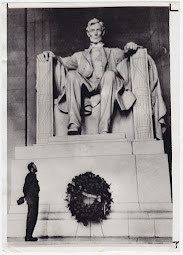Welcome back viewers
This month's Iconic Image is...
Castro at the Lincoln Memorial
Intro
This photograph was taken inside the Lincoln Memorial on April 17, 1959. It depicts a tall bearded man standing by a wreath under the statue of President Abraham Lincoln. The man is Fidel Castro, the leader of Communist Cuba. He is clearly looking upon the statue with great admiration and respect. This image would become an iconic symbol of the one man's everlasting legacy and another man's insatiable desires.
Part I
In 1959, the people of the United States watched in complete disbelief as the country of Cuba experienced a Communist take-over. The man at the head of this revolution was an ardent Marxist-Leninist guerrilla named, Fidel Castro. Castro (along with another famous guerrilla named, Che Guevara) successfully overthrew the Cuban government and declared himself, President of Cuba under a Communist government.
Knowing that the US government would not be friendly towards a communist governed nation, Castro decided that the best course of action was to meet with President Dwight David Eisenhower. However, Eisenhower declined to meet with Castro (he spent the day playing golf instead). He had his Vice President (Richard Nixon) meet with Castro on his behalf. After a three hour meeting with the Vice President, Castro decided to tour Washington DC. He was followed by an entourage of journalists and reporters.
Castro visited many landmarks and famous monuments in DC and northern Virginia (including Mount Vernon). But there was one monument in particular that Castro knew he had to see and pay tribute to a man he had admired since childhood. It was (and still is) one of Washington's most famous memorials, the Lincoln Memorial.
Part II
Castro walked up the steps of the memorial while carrying a large wreath. He then placed the wreath at the pedestal of the giant statue of President Lincoln. As he stood back and gazed at the statue, his personal photographer (Alfredo Korda) snapped an image. After the picture was taken, Castro then walked over to the engraving of Lincoln's famous Gettysburg Address. After reading it, he turned to Korda and said, "Formidable and very interesting!".
According to his biographers, Fidel Castro was very impressed by his visit to the Lincoln Memorial and mesmerized by the Gettysburg Address. He was amazed at how President Lincoln had found a way to end slavery in the United States and lead his people through the Civil War. Castro resolved, that he would do everything possible to become as revered as President Abraham Lincoln.
Epilogue
Ultimately, Castro's two-week visit to the United States did not have the consequences that he desired. Just a few months later, the US government imposed trade restrictions on Cuba. And in 1963, war nearly broke out between the US and the Soviet Union over the placement of ballistic missiles within Cuba. For the rest of the 20th century, both the United States and Cuba would continue to be at odds. It wasn't until 2015, that the two nations finally reestablished diplomatic relations.
Fidel Castro remained in power until his resignation from the Cuban presidency in the year 2008 (he was succeeded by his brother Raul). Despite his complicated relationship with the US government, there was one thing that never changed. From the day he visited in 1959 to the day he died, Castro remained an avid admirer of President Abraham Lincoln. According to his biographers, he kept a bust of the late American president on his desk his whole life and often quoted Lincoln in his speeches. Fidel Castro finally died on November 25, 2016.
Today, the photograph of Fidel Castro at the Lincoln Memorial continues to cause much debate among those who view it. For some, it represents the everlasting legacy of one of America's greatest presidents (one who even inspires the country's enemies). Some might view it as a symbol of Castro's insatiable desire to be as loved and revered as one of the most influential political figures in history. However, one thing is definitely clear. This photograph shows that even among enemies, there can still be common levels of dignity and respect for a historical figure. And that definitely gives this image a special place in the history of photography.
https://rarehistoricalphotos.com/fidel-castro-lincoln-memorial-1959/
https://www.theatlantic.com/politics/archive/2014/12/fidel-castro-lays-a-wreath-at-the-lincoln-memorial/453459/
https://about-history.com/fidel-castro-lays-a-wreath-in-front-of-the-lincoln-memorial/
https://www.inquirer.com/philly/news/nation_world/20071029_Reply_to_Bush_.html


